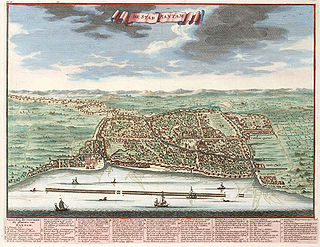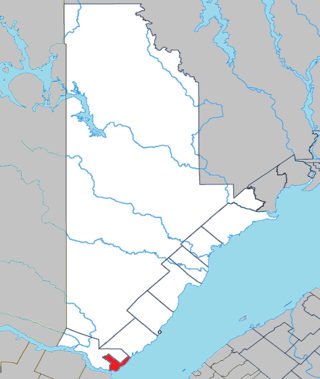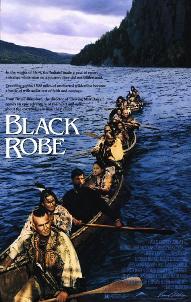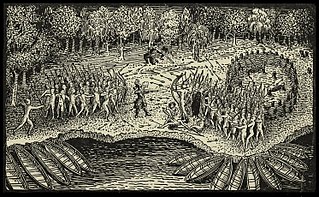Related Research Articles

1603 (MDCIII) was a common year starting on Wednesday of the Gregorian calendar and a common year starting on Saturday of the Julian calendar, the 1603rd year of the Common Era (CE) and Anno Domini (AD) designations, the 603rd year of the 2nd millennium, the 3rd year of the 17th century, and the 4th year of the 1600s decade. As of the start of 1603, the Gregorian calendar was 10 days ahead of the Julian calendar, which remained in localized use until 1923.

Samuel de Champlain was a French explorer, navigator, cartographer, draftsman, soldier, geographer, ethnologist, diplomat, and chronicler. He made between 21 and 29 trips across the Atlantic Ocean, and founded Quebec City, and New France, on 3 July 1608. An important figure in Canadian history, Champlain created the first accurate coastal map during his explorations and founded various colonial settlements.

The St. Lawrence River is a large international river in the middle latitudes of North America connecting the Great Lakes to the North Atlantic Ocean. Its waters flow in a northeasterly direction from Lake Ontario to the Gulf of St. Lawrence, traversing Ontario and Quebec in Canada and New York in the United States. A section of the river demarcates the Canada–U.S. border.

France began colonizing the Americas in the 16th century and continued into the following centuries as it established a colonial empire in the Western Hemisphere. France established colonies in much of eastern North America, on several Caribbean islands, and in South America. Most colonies were developed to export products such as fish, rice, sugar, and furs.

The Wyandot people are Indigenous peoples of the Northeastern Woodlands of North America, and speakers of an Iroquoian language, Wyandot.

New France was the territory colonized by France in North America, beginning with the exploration of the Gulf of Saint Lawrence by Jacques Cartier in 1534 and ending with the cession of New France to Great Britain and Spain in 1763 under the Treaty of Paris.

The Algonquin people are an Indigenous people who now live in Eastern Canada. They speak the Algonquin language, which is part of the Algonquian language family. Culturally and linguistically, they are closely related to the Odawa, Potawatomi, Ojibwe, Mississaugas, and Nipissing, with whom they form the larger Anicinàpe (Anishinaabeg). Algonquins are known by many names, including Omàmiwinini and Abitibiwinni or the more generalised name of Anicinàpe.
Étienne Brûlé was the first European explorer to journey beyond the St. Lawrence River into what is now known as Canada. He spent much of his early adult life among the Hurons, and mastered their language and learned their culture. Brûlé became an interpreter and guide for Samuel de Champlain, who later sent Brûlé on a number of exploratory missions, among which he is thought to have preceded Champlain to the Great Lakes, reuniting with him upon Champlain's first arrival at Lake Huron. Among his many travels were explorations of Georgian Bay and Lake Huron, as well as the Humber and Ottawa Rivers. Champlain agreed to send Brûlé, at his own request, as an interpreter to live among the Onontchataron, an Algonquin people, in 1610. In 1629, during the Anglo-French War, he escaped after being captured by the Seneca tribe. Brûlé was killed by the Bear tribe of the Huron people, who believed he had betrayed them to the Seneca.
The Beaver Wars, also known as the Iroquois Wars or the French and Iroquois Wars, were a series of conflicts fought intermittently during the 17th century in North America throughout the Saint Lawrence River valley in Canada and the Great Lakes region which pitted the Iroquois against the Hurons, northern Algonquians and their French allies. As a result of this conflict, the Iroquois destroyed several confederacies and tribes through warfare: the Hurons or Wendat, Erie, Neutral, Wenro, Petun, Susquehannock, Mohican and northern Algonquins whom they defeated and dispersed, some fleeing to neighbouring peoples and others assimilated, routed, or killed.

This section of the Timeline of Quebec history concerns the events between the foundation of Quebec and establishment of the Sovereign Council.

Events from the 1600s in Canada.

Tadoussac is a village municipality in La Haute-Côte-Nord RCM, on the north shore of the maritime section of the estuary of St. Lawrence river, in Côte-Nord region, Quebec, Canada.

Jean Nicolet (Nicollet), Sieur de Belleborne was a French coureur des bois noted for exploring Lake Michigan, Mackinac Island, Green Bay, and being the first European to set foot in what is now the U.S. state of Wisconsin.

Black Robe is a 1991 historical drama film directed by Bruce Beresford, adapted by Brian Moore from his 1985 novel of the same name. Set in the 17th century, it depicts the adventures of a Jesuit missionary tasked with founding a mission in New France. To do so, he must traverse 1500 miles of harsh wilderness with the help of a group of Algonquins, facing danger from both the unfamiliar environment and rival tribes. The title refers to the nickname given to the Jesuits by the Algonquins, referring to his black cassock.
Events from the year 1609 in Quebec.
Events from the year 1610 in Quebec.
François Gravé, said Du Pont, was a Breton navigator, an early fur trader and explorer in the New World.

During the summer of 1609, Samuel de Champlain attempted to form better relations with the local native tribes. He made alliances with the Wendat and with the Algonquin, the Montagnais, and the Etchemin, who lived in the area of the St. Lawrence River. These tribes demanded that Champlain help them in their war against the Iroquois, who lived further south. Champlain set off with 9 French soldiers and 300 natives to explore the Rivière des Iroquois, and became the first European to map Lake Champlain. Having had no encounters with the Iroquois at this point many of the men headed back because of the danger of traveling in the country of their enemies, leaving Champlain with only 2 Frenchmen and 60 natives.

A tabagie is a room designated for smoking tobacco and socializing.
In every Palace was a Tabagie, a high large room with a dozen contented saturnine figures round a large long table, a long Dutch pipe in the mouth of each.

The Battle of Sorel occurred on June 19, 1610, with Samuel de Champlain supported by the Kingdom of France and his allies, the Huron, Algonquin people, and Montagnais that fought against the Mohawk people in New France at present-day Sorel-Tracy, Quebec. The forces of Champlain armed with the arquebus engaged and killed or captured nearly all of the Mohawks. The battle ended major hostilities with the Mohawks for twenty years.
References
- ↑ Erik R. Seeman (28 September 2011). Death in the New World: Cross-Cultural Encounters, 1492-1800. University of Pennsylvania Press. pp. 112–. ISBN 978-0-8122-0600-5 . Retrieved 7 July 2013.
- ↑ "France in America: The Foundation of the Alliances / La France en Amérique: La fondation des alliances". Library of Congress Global Gateway, France in America. Retrieved 2013-07-07.
- ↑ Conrad Heidenreich; K. Janet Ritch (11 November 2010). Samuel de Champlain before 1604: Des Sauvages and other Documents Related to the Period. MQUP. pp. 257–. ISBN 978-0-7735-9100-4 . Retrieved 7 July 2013.